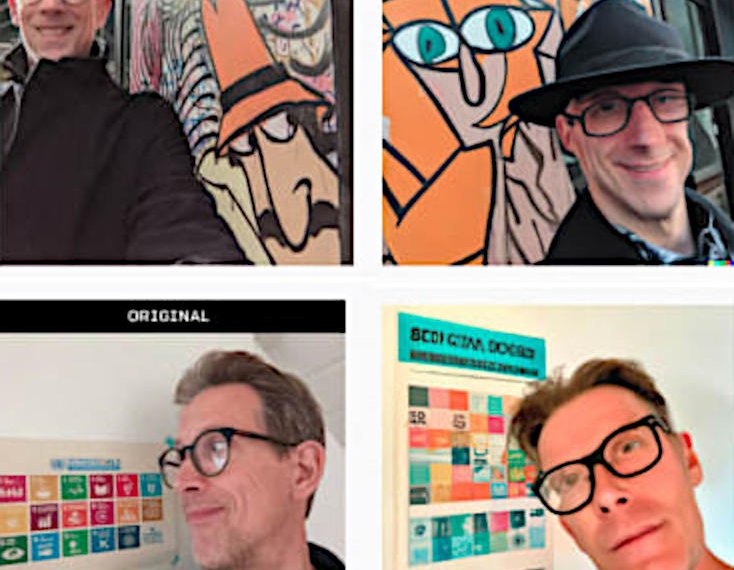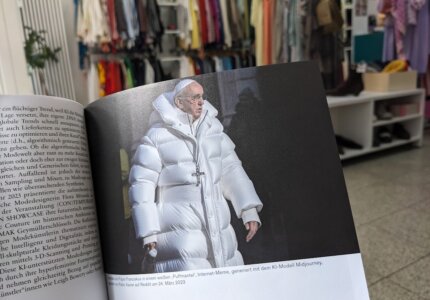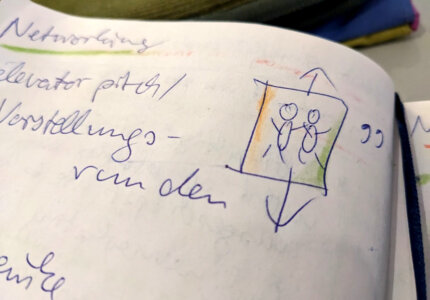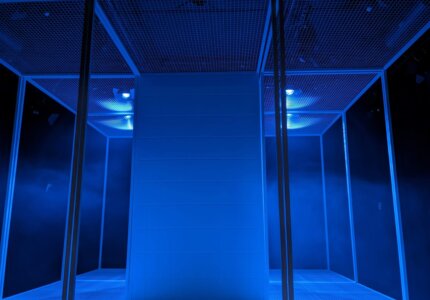KI-Kunst (AI Art) sieht schön und spannend aus, macht aber auch deutlich, wie wenig die Maschinen den Sinn verstehen.
Diesen Artikel gibt es auch auf Englisch und bei DEV.to.
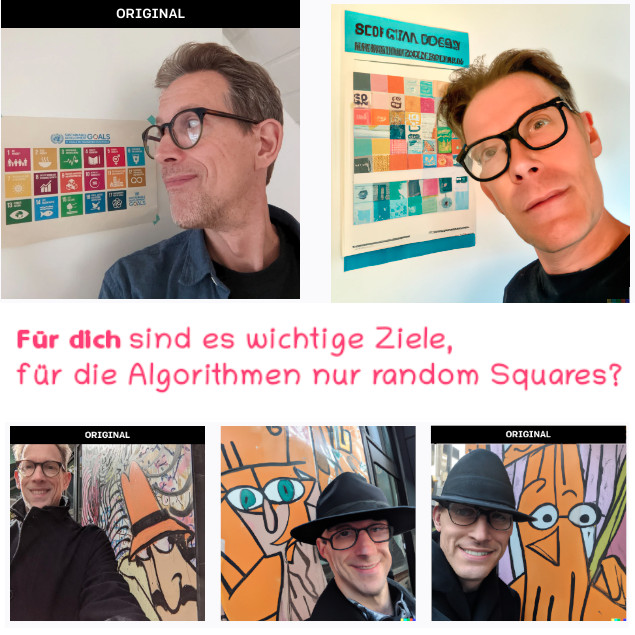
Für dich sind es wichtige Ziele, aber für die Algorithmen nur zufällige Zeichen? Collage mit echten Fotos und computergeneriereten Variationen, die dem echten Menschen den Hut des Graffiti-Characters aufsetzen und bedeutsame Schaubilder sinnfrei entstellen. Das vermeintliche zweite „Original“ auf dem rechten Bild ist mehr oder weniger frei erfunden.
Kurz nach der ursprünglichen Version dieses Artikels erschien chatGPT, ein Chatbot, der erstaunlich viel Aufsehen erregte – mehr noch als die usprünglich diskutierten visuellen Algorithmen – und der manche bereits zum voreiligen Schluss verleitete, Texten und sogar Programmierung werde zukünftig automatisiert von Maschinen erledigt und nun würden auch die kreativen Menschen alle arbeitslos. Gähn! Machine Learning ist keine „künstliche Intelligenz“, und dass die Automaten nun denselben Schrott nachbauen, der ihnen zum Training vorgesetzt wurde, ist eigentlich wenig überraschend. Altkluge Allgemeinplätze mögen hilfreich erscheinen, bleiben aber unbelegtes Halbwissen ohne Quellenangabe.
Ein paar Worte zur Begriffsklärung: „Machine Learning“ (maschinelles Lernen) beschreibt diese Technologien deutlich treffender als der irreführende Ausdruck „künstliche Intelligenz“. Es geht hier weniger um Denken oder gar Kreativitiät, sondern um das Erkennen, Reproduzieren und Variieren von Muster. Im Gegensatz zu Algorithmen werden beim Programmieren nicht die einzelnen Entscheidungsschritte vorgegeben, sondern bloß das Grundgerüst zu erlernender Prozesse. Denkfehler und Diskriminierung werden dadurch schwerer nachvollziehbar.
Maschinen reproduzieren menschliche Fehler und Vorurteile
Maschinen werden mit vorhandenen Daten trainiert, um diese später wie fleißige Schüler:innen wiederzugeben und auf altkluge Weise mit hilfreichen Antworten zu verblüffen. Manche der erzeugten Bilder sehen täuschend echt wie ein Foto oder wie ein historisches Gemälde aus, und Programmiercode und dessen Erklärungen ist teilweise hilfreich und einsatzbereit – aber eben nur teilweise. Bei näherer Betrachtung wird schnell deutlich, wo die Technik nicht nur aktuell, sondern grundsätzlich an ihre Grenzen stößt. Es mangelt an Intiution, Gefühl und Werten.
Vielleicht ist und bleibt das der größte Kritikpunkt an automatischer Text- und Bilderzeugung. Computer lernen nicht nur, sinnvolle Zusammenhänge zu erkennen, sie lernen und reproduzieren auch kritiklos alle Fehler und Vorurteile, die sich in den Trainingsdaten manifestiert.
Abgesehen vom künstlerischen und wirtschaftlichen Nutzen (Prototyping für Mode, Architektur, Industrie- und Web-Design) erschließt sich das weite Feld der manipulativen KI (glaubaftere Fake News, verstärkte Affirmation bestehender Klischees, Rassismus und Schönheitsidealen) aber auch bloß als eine neue, sichtbare Form dieser eben schon lange bestehenden Manipulation. KI-Kunst und Chatbots sind neue Werkzeuge und Ausdrucksmittel, wie damals die Fotografie mit Retouche, Doppelbelichtung und ähnlichem. Damals wie heute faszinierte das Neuen. Angeblich seien ja Kinobesucher vor der gefilmten Dampflokomotive auf der Leinwand geflohen, während andere das Hörspiel des vermeintlichen Marsmenschen-Angriffs angeblich für eine Nachrichtensendung hielten.
An der aktuellen KI-Kunst stört mich persönlich auch ihre Klischeehaftigkeit und künstliche Ästhetik. Das stört mich allerdings auch an den echten, aber nachbearbeiteten, Fotografien auf Instagram. Furchtbar inszeniert und komischen Influencern folgen, aber wenn jemand mal eine schräge Straßenszene fotografiert, die nicht dem üblichen Schema entspricht, gibt es kaum Likes.
„Das ist fein“ – aber ist das Kunst?

Ein Beispiel weniger glatter Ästhetik: Variationen des „This is fine“-Memes, erzeugt mit DALL·E 2 von OpenAI
Die aktuelle KI-Kunstszene kann ich noch nicht wirklich beurteilen, aber auf den ersten Blick vermisse ich Kunst- und Gesellschaftskritik. Zu viel Klischee, zu wenig Punk! Immer noch 1000x besser als der bisherige NFT-Kram, aber, abgesehen von einigen lustigen und ästhetischen Aspekten, aus meiner Sicht erstaunlich enttäuschend, zumal scheinbar so viel Rechenzeit und künstlerisches Mitdenken investiert wurde.
Der folgende englische Artikel wird noch übersetzt und in die ursprünglichen Notizen integriert! (TODO)
Menschlich erstellte Textschnippsel als „Work in Progress“
Computer generated, so called AI art (or „artificial intelligence art“) looks nice at first sight, and maybe somewhat disturbing when taking a closer look. But interaction with machines could help us understand what humanity is all about.
Developers who are interested in the technological aspects should have a look at my DEV blog post: Artificial „Intelligence“ and Controversial Ideas about Future Technology. But let’s have a look at some of the latest trends using computers and machine learning to create visuals.
This article’s cover image features original photography side by side with seemingly similar imagery created by a computer. Note that the artificial versions of myself are wearing a black hat that does not exists but on the street art mural I had been standing next to.
Discussing the Future of the Web
I try to keep an open mind for legitimate and helpful use cases of new technology, although there are some new trends that don’t really spark joy in my heart. But I still remember when, in times long gone, before the year 2000, I had been fascinated by early metaverse and cyberpunk ideas in science fiction literature, but also by the idea of an open, decentralized, interconnected global network which is the the world wide web or the internet. Unfortunately, it got more commercialized and centralized, its „western“ zone dominated by an oligopoly of companies mostly based in California, USA. So we have freedom of speech, but most chose to follow „though leaders“ and influencers on (anti)social media, instead of making up their own mind.
Cyberpunk Literature
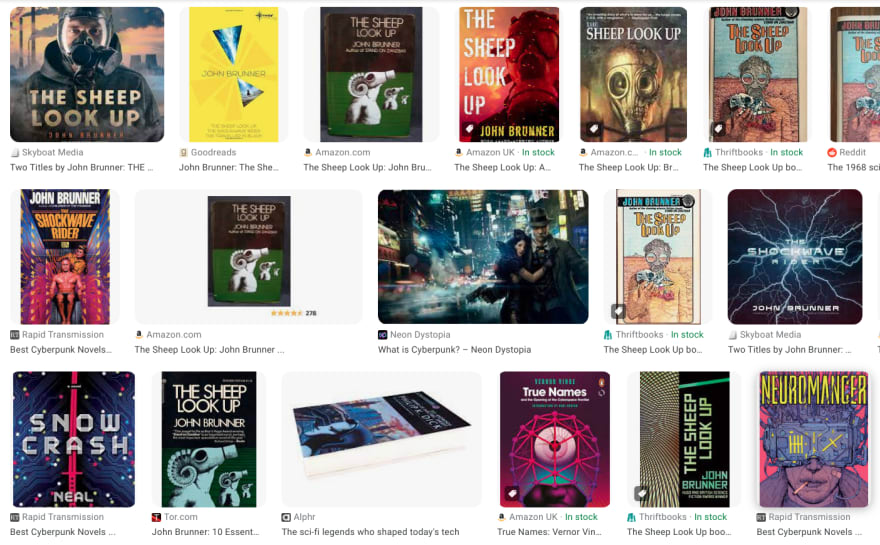
There are several blog post about futurist novels that include descriptions of virtual reality and global communication, like The Sheep Look Up by John Brunner and Snow Crash by Neal Stephenson. Read my post about dystopian, science-fiction, and fantasy literature as social criticism for more links and inspiration!
While some of our current technology and future research might have been inspired by literary sources, it falls short of its potential.
As I replied to A.J. Sadauskas on mastodon.social,
the current Web3 enthusiasts offer no efficient alternatives to the commercial and centralised Web 2.0, while the fediverse and IndieWeb movement focus on the decentral and robust principles that the internet was build upon and which made email, usenet (NNTP, described in RFC 977 in February 1986), HTTP and HTML such a success in the first place.
Is Artificial „Intelligence“ dumb and biased?
Machine learning refers to the fact, that we can train algorithms using input data, not only accelerating the time it takes to develop complex applications, but also to create interfaces generating unexpected output in a way that makes them seem to be sentient and intelligent.
But feeding large amounts of mainstream culture’s output into machines tends to reproduce undesirable prejudice and bias found in our society and our past to present culture.
This phenomenon is not limited to machine learning, but when it manifests in code and machines built and documented by human teams, it might be easier to point out and adjust.
Read how Dr. Joy Buolamwini is fighting bias in algorithms and how to make technology serve all of us, not just the privileged few.
DALL·E and Midjourney: Digital Artwork thanks to Machine Learning
The Open AI art movement on the other hand already created tons of detailed high resolution images, either photo-realistic or looking like a handcrafted painting, often creating an „uncanny valley“ effect due to misplaced details and seemingly unimportant errors that no human artists would ever have thought about. While many digital artists seemed to favor a sinister, dystopian gamer aesthetic which has already been popular on platforms like deviantart, other artists, like my friend Andy „Retinafunky“ Weisner, experiment with said flaws and different aesthetics.
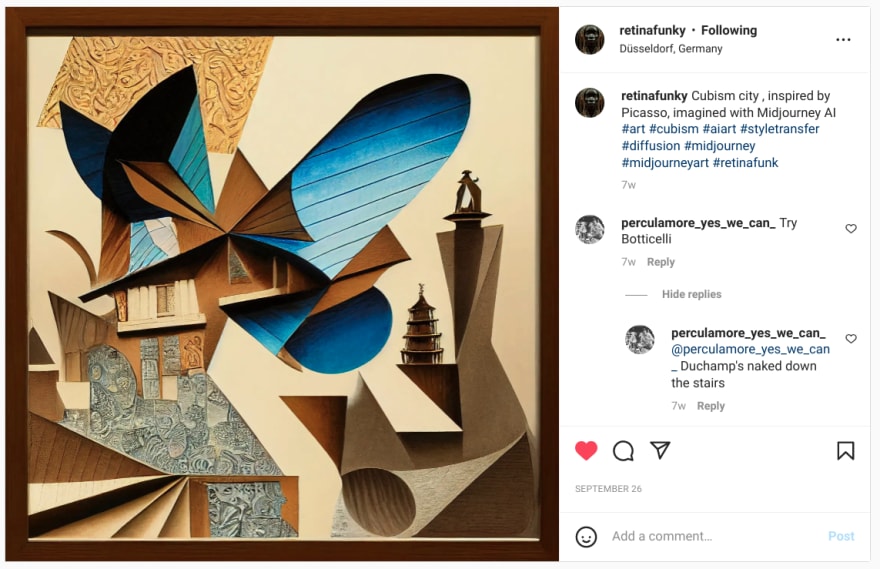
KI-Kritik aber aus den falschen Gründen
Some traditionalists criticize AI Art for the wrong reasons, denouncing it as plagiarism or no real work, as they fail to see innovation and creative effort.
Looking back in history, many famous artists had assistants, many of them stayed anonymous, some got famous as well. So we might conclude that you can be a brilliant artist without being the one painting every single brushstroke.
Photography, now an accepted art form exhibited in galleries, was criticized in the beginning in a discussion much like many of today’s controversies about algorithmic and AI art. When photography was not art, „the fear has sometimes been expressed that photography would in time entirely supersede the art of painting. Some people seem to think that when the process of taking photographs in colors has been perfected and made common enough, the painter will have nothing more to do.“
Just like with photography, to produce a stunning work of art using modern algorithmic tools, you can either be extremely lucky, or you have to experiment and be inspired, taking your time to learn the tools and parameters, evolve and improve your art over time.
But what are my points about AI art them? I fear with AI art, we are passing too much power to algorithms thus losing control and losing touch to the real world, nature, people and social, ethical and environmental topics.
Nothing left but random squares?
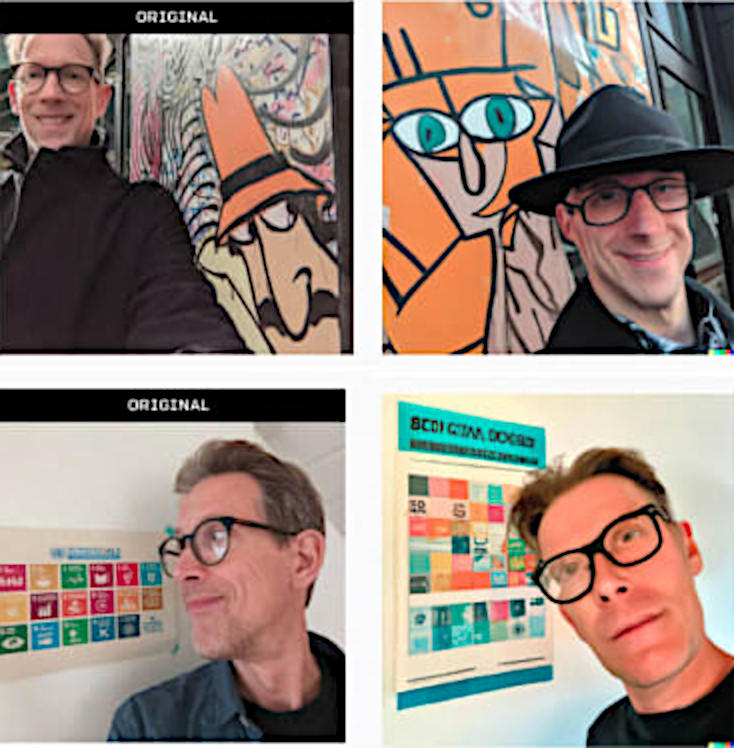
Here is an image of myself in front of a poster showing the United Nations‘ 17 Sustainability Goals (SDG). All variations of this picture created by the public version of Open AI’s Dall·E distort the icons and text and replace it with illegible symbols or random letters.
I fear that this might sum up how the current „AI“ systems view our world, and it shows that they are either not that intelligent after all, or that their capabilities might prioritize aspects that take the relevant meaning out of our culture, valuing style, aesthetics and presentation much higher than content and context.
But then again, this proves the point, that we still need actual artists, and that Dall·E, Midjourney, and other tools are power tools, but still not very useful without human interaction.
I think that time will tell, and if practiced seriously, AI is a valuable and innovative tool for digital artists.
Other forms of Digital Art
There is creational art, creating images, objects, or text, done by creative artists like bleeptrack or c.o.u.d.e. There is augmented reality art, combining actual real-world artworks seem to become alive using AR apps like artivive when looking at an enhanced painting. You can see some images and read more about interactive art in my post about the Universe of Time event by Flux Collective in this blog.
As I said earlier, there is a lot going on that I am very skeptical and critical about, like Web3, the metaverse, and the NFT art scene.
Wasting energy to deceive people with NFT and the Metaverse
You may have seen the various images of a „bored ape“ cartoon character, often used as a profile picture by people not even creating any artwork whatsoever, trying to profit from the hype around blockchain, cryptocurrencies and non fungible tokens (NFT) investing a lot of money in hope for return of investment.
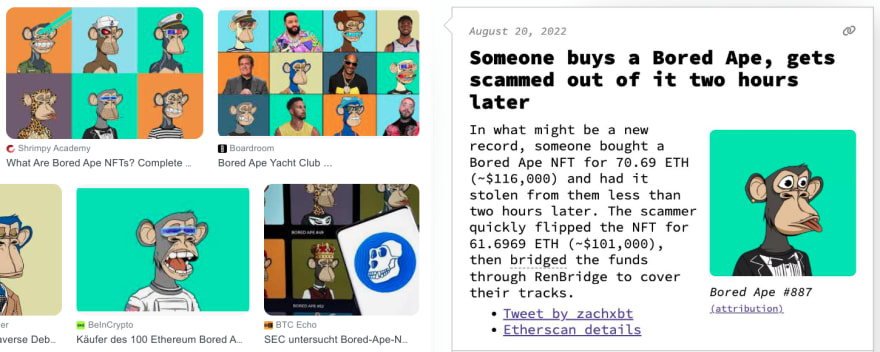
NFT and cryptocurrencies offer people to participate the profitable art market and other investments without having a bank account, a credit card, or being recognized by established gallery owners, it also created a large black market to scam aspiring artists, developers, and other hopeful individuals. Mining cryptocurrency using energy-consuming calculations in a blockchain is a waste of energy that could better be used for other purposes, even more so in the face of human-made climate change already starting to destroy our planet.
NFT and the energy consumption of some of the latest trends in information technology. Training a single AI model can emit as much carbon as five cars in their lifetimes. It seems hard to calculate the CO₂ emissions of NFT „mining“, but the popular cryptocurrency Ethereum uses about 31 terawatt-hours (TWh) of electricity a year, about as much as the whole of Nigeria, according to an estimate based on the Ethereum Energy Consumption Index.
„Recreating“ extinct species and places in a virtual enviroment, like Tuvalu „uploading itself into the metaverse“ only accessible by using visual technology (headsets, cameras, displays) does not help either, and the current pitiable state of the so-called metaverse makes it look even more ridiculous and it rather reminds me of the final scene of the dystopian science fiction film Soylent Green.
A virtual reality does have its benefits, but unlike a real environment, it does not provide sunlight, fresh air, delicious food and have you ever tried to dance or swim in a virtual environment? You might remember Second Life: most people seemed to enjoy creating a second life as boring as their first one.
Same with #chatGPT and visual image generation: many people seem to get excited about the output that looks impressive at first sight. But like the images‘ uncanny valley artifacts, take a good look at generated code unless all you plan to do is submit a solution to a coding kata.
Summary
Web3 misses the point of their alleged goals like decentralization, equity and helping to create a better, more diverse and creative world through digitization. Web3 enthusiasts waste energy and compromise security and integrity of data and money, and give up freedom and agency, allowing to be manipulated by algorithms and greedy companies.
Copilot, tabnine, and ChatGPT as tools for developers
We can use artificial „intelligence“ as a tool. As a tool for artists, as a tool for copywriters, and as a tool for coding, too. I admit that I have been using @tabnine, GitHub copilot, JetBrains context actions, and static code analysis like eslint, stylelint, phpstan, and code sniffer. I also use Grammarly to improve my writing, especially when posting in English, which is not my native language. I have been using all of those tools at the same time, they have saved me some debugging detours, some keystrokes, and some StackOverflow searches for generating boilerplate code and generic documentation. And I will also evaluate how chatGPT might come in handy. But don’t fear that any of those tools might seriously put my job as a senior developer in danger.
So there are hopeful digital innovations that might help us build a better tomorrow despite, so let’s take our time and find out how!
